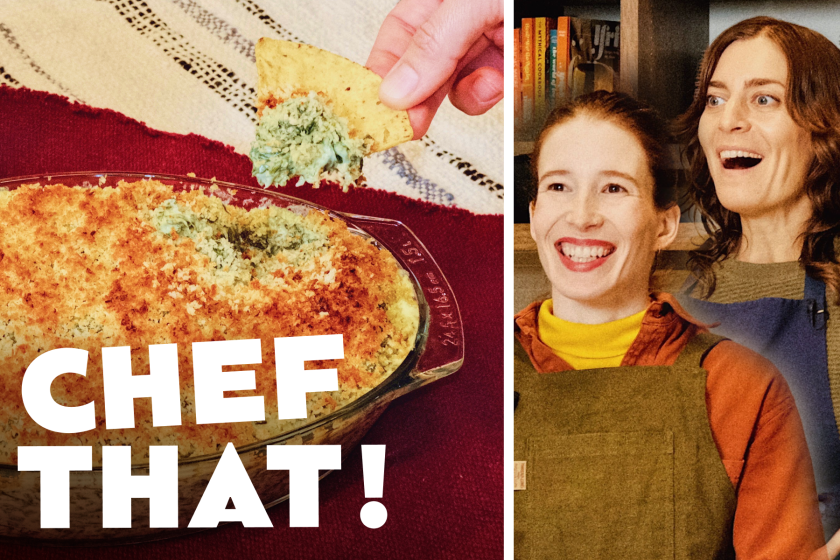Buyers Can Save a Bunch by Getting Wine at Auction
- Share via
LONDON — If you can tell a pinot noir from a cabernet sauvignon at 50 paces and Chateau Plonk 1997 just won’t do anymore, it’s time to admit to a drinking problem: A penchant for fine wines can be expensive.
For quaffing, impressing the in-laws or stashing away, wine auctions are one way to buy something you’d rather swallow than spit, often at below retail prices.
“There’s much more pleasure in drinking something wonderful and knowing you paid a low price for it,” said Michael Hollings, a London businessman who’s built up his cellar at auction over the past 10 years.
Experts say those considering buying wine at auction should come prepared with a basic idea of what they’re after and how much they’re willing to spend.
“There’s no use in just plunging in,” said Harriet Joll, senior wine specialist at Christie’s in London.
Tasting courses from the adult education services or local experts are good starting points, while bookstores stock a range of wine guides. Going to a couple of sales to observe, or studying catalogs first will give an idea of the sort of things on offer and estimates of what they’ll fetch.
Wines on offer can start from less than $81 for a case of 12, and go to thousands for something rare and special. Major auctioneers include Christie’s and Sotheby’s. They hold sales in London every month, as well as in European capitals and now in New York. Smaller auction houses, like Bonham’s or Phillips, will often have a wider selection of more affordable wines.
*
Auctions are a source of stock for wine merchants and restaurants, so prices are more competitive than in shops. However, private buyers are welcomed, and auctioneers can be a good source of knowledge about the stock on offer.
“It used to be something for the elite,” said Serena Sutcliffe, head of the wine department at auctioneers Sotheby’s International. “But it’s democratized extraordinarily, with more and more people appreciating fine wines.”
Buyers in the Far East are becoming increasingly important for top selections, although they’re unlikely to attend in person. In fact, many avid wine collectors prefer to send in their bids by fax, to avoid getting carried away and splurging for something out of their league.
Few people would be willing, or able, to pay $36,000 for a case of Le Pin 1982, as a buyer from the U.S. did at Sotheby’s in September.
However, what about a case of Puligny Montrachet 1992, a white burgundy, estimated at $205 to $255? It comes from composer Andrew Lloyd-Webber’s collection, being auction by Sotheby’s this week.
The whole sale of 18,000 bottles is expected to be worth more than $3.17 million, and contains some of the greatest classic wines of the century.
“Wine is alive, and I now realize that I have been hogging far too much of it,” Lloyd-Webber said in a press release from Sotheby’s describing the collection. “It is time for a clear out.”
That’s a typical source of wines that come up for auction. Some collectors run out of room, or find that they happen to have laid down large quantities of something which is now in its prime, and will command spectacular prices if it’s sold.
Like art, wine can have investment potential, but it’s important to buy what you like. For something that will continue to appreciate in quality as well as price, Sutcliffe recommends Bordeaux from reputable chateaux from 1988, 1989 and 1990.
“They’re all great vintages, and still young so they will continue to increase in value,” she said.
Another good bet would be red burgundy from 1993, which has “terrific keeping potential.”
However, those now paying thousands of pounds for magnificent years like 1947 and 1961 are buying wines for pleasure, not profit, Sutcliffe says.
“You don’t buy a wine of that age to store away for longer,” she said. “The investment side of it’s already happened.”
It is important that anything you buy is stored in a cool, damp place, if you intend to keep it awhile. The auction houses will try to establish that wine has been kept properly.
One hint: Don’t shy away from damp-damaged labels, since the conditions that decay paper outside the bottle help preserve the wine inside it.
Auctioneers will do their best to filter out blighted bottles, and say that if something is seriously off they could be open to discussion. However, the onus is more on the buyer than would be the case at a retail outlet.
“One of the things to remember about buying at auction,” Hollings said, “is the risk that you can end up with very expensive cooking wine.”
More to Read
Eat your way across L.A.
Get our weekly Tasting Notes newsletter for reviews, news and more.
You may occasionally receive promotional content from the Los Angeles Times.










